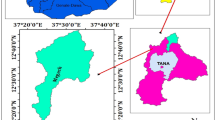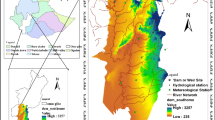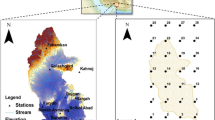Abstract
Regional climate model (RCM) outputs are often used in hydrological modeling, in particular for streamflow forecasting. The heterogeneity of the meteorological variables such as precipitation, temperature, wind speed and solar radiation often limits the ability of the hydrological model performance. This paper assessed the sensitivity of RCM outputs from the PRUDENCE project and their performance in reproducing the streamflow. The soil and water assessment tool was used to simulate the streamflow of the Rhone River watershed located in the southwestern part of Switzerland, with the climate variables obtained from four RCMs. We analyzed the difference in magnitude of precipitation, maximum and minimum air temperature, and wind speed with respect to the observed values from the meteorological stations. In addition, we also focused on the impact of the grid resolution on model performance, by analyzing grids with resolutions of 50 × 50 and 25 × 25 km2. The variability of the meteorological inputs from various RCMs is quite severe in the studied watershed. Among the four different RCMs, the Danish Meteorological Institute provided the best performance when simulating runoff. We found that temperature lapse rate is significantly important in the mountainous snow and glacier dominated watershed as compared to other variables like precipitation, and wind speed for hydrological performance. Therefore, emphasis should be given to minimum and maximum temperature in the bias correction studies for downscaling climatic data for impact modeling in the mountainous snow and glacier dominated complex watersheds.







Similar content being viewed by others
References
Abbaspour KC, Yang J, Maximov I, Siber R, Bogner K, Mieleitner J, Zobrist J, Srinivasan R (2007) Modelling hydrology and water quality in the pre-ailpine/alpine Thur watershed using SWAT. J Hydrol 333(2–4):413–430
Ahl RS, Woods SW, Zuuring HR (2008) Hydrologic calibration and validation of SWAT in a snow-dominated rocky mountain watershed, Montana, USA. J Am Water Resour Assoc 44(6):1411–1430. doi:10.1111/j.1752-1688.2008.00233.x
Arnold JG, Srinivasan R, Muttiah RS, Williams JR (1998) Large area hydrologic modeling and assessment, part 1: model development. JAWRA 34(1):73–89. doi:10.1111/j.1752-1688.1998.tb05961.x
Beniston M (2010) Impacts of climatic change on water and associated economic activities in the Swiss Alps. J Hydrol. doi:10.1016/j.jhydrol.2010.06.046
Beniston M, Goyette S (2007) Changes in variability and persistence of climate in Switzerland: exploring 20th century observations and 21st century simulations. Glob Planet Change 57(1–2):1–15. doi:10.1016/j.gloplacha.2006.11.004
Beniston M, Uhlmann B, Goyettea S, Lopez-Morenob JI (2011) Will snow-abundant winters still exist in the Swiss Alps in an enhanced greenhouse climate? Int J Climatol 31(9):1257–1263. doi:10.1002/joc.2151
Bordoy R, Burlando P (2012) Bias correction of regional climate model simulations in a region of complex orography. J Appl Meteorol Climatol 52(1):82–101. doi:10.1175/jamc-d-11-0149.1
Bosshard T, Kotlarski S, Ewen T, Schaer C (2011) Spectral representation of the annual cycle in the climate change signal. Hydrol Earth Syst Sci 15(9):2777–2788. doi:10.5194/hess-15-2777-2011
Chen H, Xu C-Y, Guo S (2012) Comparison and evaluation of multiple GCMs, statistical downscaling and hydrological models in the study of climate change impacts on runoff. J Hydrol 434–435:36–45. doi:10.1016/j.jhydrol.2012.02.040
Christensen JH, Christensen OB (2007) A summary of the PRUDENCE model projections of changes in European climate by the end of this century. Clim Change 81:7–30
Christensen JH, Christensen OB, Lopez P, van Meijgaard E, Botzet M (1996) The HIRHAM4 regional atmospheric climate model. DMI Technical Report 96-4. DMI, Copenhagen Ø
Christensen JH, Carter TR, Giorgi F (2002) PRUDENCE employs new methods to assess European climate change. EOS (American Geophysical Union Newsletter) 83:13
Debele B, Srinivasan R, Gosain AK (2010) Comparison of process-based and temperature-index snowmelt modeling in SWAT. Water Resour Manag 24(6):1065–1088
Doscher R, Willén U, Jones C, Rutgersson A, Meier HM, Hansson U, Graham LP (2002) The development of the regional coupled ocean-atmosphere model RCAO. Boreal Environ Res 7(3):183–192
Fette M, Weber C, Peter A, Wehrli B (2007) Hydropower production and river rehabilitation: a case study on an alpine river. Environ Model Assess 12(4):257–267
Fontaine TA, Cruickshank TS, Arnold JG, Hotchkiss RH (2002) Development of a snowfall-snowmelt routine for mountainous terrain for the soil water assessment tool (SWAT). J Hydrol 262(1–4):209–223
Giorgi F, Marinucci MR, Bates GT (1993) Development of a second-generation regional climate model (RegCM2). Part I: Boundary-layer and radiative transfer processes. Mon Weather Rev 121(10):2794–2813
Graham LP, Andreasson J, Carlsson B (2007) Assessing climate change impacts on hydrology from an ensemble of regional climate models, model scales and linking methods: a case study on the Lule River basin. Clim Change 81:293–307. doi:10.1007/s10584-006-9215-2
Gupta HV, Sorooshian S, Yapo PO (1999) Status of automatic calibration for hydrologic models: comparison with multilevel expert calibration. J Hydrol Eng 4(2):135–143. doi:10.1061/(asce)1084-0699(1999)4:2(135)
Hock R (2003) Temperature index melt modelling in mountain areas. J Hydrol 282(1–4):104–115. doi:10.1016/s0022-1694(03)00257-9
Hwang S, Graham W, Adams A, Geurink J (2013) Assessment of the utility of dynamically-downscaled regional reanalysis data to predict streamflow in west central Florida using an integrated hydrologic model. Reg Environ Change 1–12. doi:10.1007/s10113-013-0406-x
Jiang P, Gautam MR, Zhu J, Yu Z (2013) How well do the GCMs/RCMs capture the multi-scale temporal variability of precipitation in the Southwestern United States? J Hydrol 479:75–85. doi:10.1016/j.jhydrol.2012.11.041
Klok EJ, Jasper K, Roelofsma KP, Gurtz J, Badoux A (2001) Distributed hydrological modelling of a heavily glaciated Alpine river basin. Hydrol Sci J 46(4):553–570
Leander R, Buishand TA (2007) Resampling of regional climate model output for the simulation of extreme river flows. J Hydrol 332(3–4):487–496. doi:10.1016/j.jhydrol.2006.08.006
Lenderink G, Buishand A, van Deursen W (2007) Estimates of future discharges of the river Rhine using two scenario methodologies: direct versus delta approach. Hydrol Earth Syst Sci 11(3):1143–1159
Lettenmaier DP, Wood AW, Palmer RN, Wood EF, Stakhiv EZ (1999) Water resources implications of global warming: a US regional perspective. Clim Change 43(3):537–579. doi:10.1023/a:1005448007910
Liechti TC, Matos JP, Boillat J-L, Schleiss AJ (2012) Comparison and evaluation of satellite derived precipitation products for hydrological modeling of the Zambezi River Basin. Hydrol Earth Syst Sci. doi:10.5194/hess-16-489-2012
Liu W, Cai T, Fu G, Zhang A, Liu C, Yu H (2013) The streamflow trend in Tangwang River basin in northeast China and its difference response to climate and land use change in sub-basins. Environ Earth Sci 69(1):51–62
Masih I, Maskey S, Uhlenbrook S, Smakhtin V (2011) Assessing the impact of areal precipitation input on streamflow simulations using the SWAT model1. J Am Water Resour Assoc 47(1):179–195. doi:10.1111/j.1752-1688.2010.00502.x
Maurer EP, Hidalgo HG (2008) Utility of daily vs. monthly large-scale climate data: an intercomparison of two statistical downscaling methods. Hydrol Earth Syst Sci 12(2):551–563
Maurer E, Wood A, Adam J, Lettenmaier D, Nijssen B (2002) A long-term hydrologically based dataset of land surface fluxes and states for the conterminous United States. J Clim 15:3237–3251
Meile T, Boillat JL, Schleiss A (2010) Hydropeaking indicators for characterization of the Upper-Rhone River in Switzerland. Aquat Sci 73(1):171–182
Moriasi DN, Arnold JG, Van Liew MW, Bingner RL, Harmel RD, Veith TL (2007) Model evaluation guidelines for systematic quantification of accuracy in watershed simulations. Trans Asabe 50(3):885–900
Morid SG, Gosain AK, Keshari AK (2004) Response of different snowmelt algorithms to synthesized climatic data for runoff simulation. J Earth Space Phys 30(1):1–4
Murphy J (1999) An evaluation of statistical and dynamical techniques for downscaling local climate. J Clim 12(8):2256–2284. doi:10.1175/1520-0442(1999)012<2256:aeosad>2.0.co;2
Nash JE, Sutcliffe JV (1970) River flow forecasting through conceptual models part I: a discussion of principles. J Hydrol 10(3):282–290. doi:10.1016/0022-1694(70)90255-6
Neitsch SL, Arnold JG, Kiniry J, Williams JR (2005) Soil and water assessment tool theoretical documentation. USDA Agricultural Research Service and TexasA & MBlackland Research Center, Temple, Texas
Obeysekera J (2013) Validating climate models for computing evapotranspiration in hydrologic studies: how relevant are climate model simulations over Florida? Reg Environ Change 1–10. doi:10.1007/s10113-013-0411-0
Pal JS, Small EE, Eltahir EA (2000) Simulation of regional‐scale water and energy budgets: representation of subgrid cloud and precipitation processes within RegCM. J Geophys Res Atmos (1984–2012) 105(D24):29579–29594
Pal JS, Giorgi F, Bi X (2004) Consistency of recent European summer precipitation trends and extremes with future regional climate projections. Geophys Res Lett 31(13)
Pavlik D, Söhl D, Pluntke T, Mykhnovych A, Bernhofer C (2012) Dynamic downscaling of global climate projections for Eastern Europe with a horizontal resolution of 7 km. Environ Earth Sci 65(5):1475–1482
Pepin N, Losleben M (2002) Climate change in the Colorado Rocky Mountains: free air versus surface temperature trends. Int J Climatol 22(3):311–329. doi:10.1002/joc.740
Pradhanang SM, Anandhi A, Mukundan R, Zion MS, Pierson DC, Schneiderman EM, Matonse A, Frei A (2011) Application of SWAT model to assess snowpack development and streamflow in the Cannonsville watershed, New York, USA. Hydrological Processes n/a–n/a. doi:10.1002/hyp.8171
Rahman K, Maringanti C, Beniston M, Widmer F, Abbaspour K, Lehmann A (2013) Streamflow modeling in a highly managed mountainous glacier watershed using SWAT: the upper Rhone River watershed case in Switzerland. Water Resour Manag 27(2):323–339. doi:10.1007/s11269-012-0188-9
Raneesh KY, Santosh GT (2011) A study on the impact of climate change on streamflow at the watershed scale in the humid tropics. Hydrol Sci J 56(6):946–965
Salzmann N, Mearns LO (2012) Assessing the performance of multiple regional climate model simulations for seasonal mountain snow in the upper Colorado River Basin. J Hydrometeorol 13(2):539–556. doi:10.1175/2011jhm1371.1
Schaefli B, Hingray B, Musy A (2007) Climate change and hydropower production in the Swiss Alps: quantification of potential impacts and related modelling uncertainties. Hydrol Earth Syst Sci 11(3):1191–1205
Schoetter R, Hoffmann P, Rechid D, Schluenzen KH (2012) Evaluation and bias correction of regional climate model results using model evaluation measures. J Appl Meteorol Climatol 51(9):1670–1684. doi:10.1175/jamc-d-11-0161.1
Taylor KE (2001) Summarizing multiple aspects of model performance in a single diagram. J Geophys Res Atmospheres 106(D7):7183–7192
van Griensven A, Meixner T, Grunwald S, Bishop T, Diluzio A, Srinivasan R (2006) A global sensitivity analysis tool for the parameters of multi-variable catchment models. J Hydrol 324(1–4):10–23. doi:10.1016/j.jhydrol.2005.09.008
Wang X, Melesse AM (2005) Evaluation of the swat model’s snowmelt hydrology in a northwestern Minnesota watershed. Trans Asae 48(4):1359–1376
Zhang XS, Srinivasan R, Debele B, Hao FH (2008) Runoff simulation of the headwaters of the Yellow River using the SWAT model with three snowmelt algorithms. J Am Water Resour Assoc 44(1):48–61. doi:10.1111/j.1752-1688.2007.00137.x
Acknowledgments
Most of the work was done during the PhD program fellowship at University of Geneva with funding from EU FP 7 project ACQWA [Assessing climate change impact on water quality and quantity] under Grant Nr. 212250. We wish to thank the Federal Office of Meteorology and Climatology MeteoSwiss for providing the daily precipitation, maximum and minimum temperatures, and wind speed required for building the hydrological model. The geographic data was obtained from Federal Office for the Environment (FOEN). We also acknowledge equally the ALPIQ and KW-MATTMARK hydropower companies for providing discharge and lake level data. The coordinates of the intake points were collected from the hydropower consulting engineers E-dric (www.e-dric.ch).
Author information
Authors and Affiliations
Corresponding author
Electronic supplementary material
Below is the link to the electronic supplementary material.
Rights and permissions
About this article
Cite this article
Rahman, K., Etienne, C., Gago-Silva, A. et al. Streamflow response to regional climate model output in the mountainous watershed: a case study from the Swiss Alps. Environ Earth Sci 72, 4357–4369 (2014). https://doi.org/10.1007/s12665-014-3336-0
Received:
Accepted:
Published:
Issue Date:
DOI: https://doi.org/10.1007/s12665-014-3336-0




